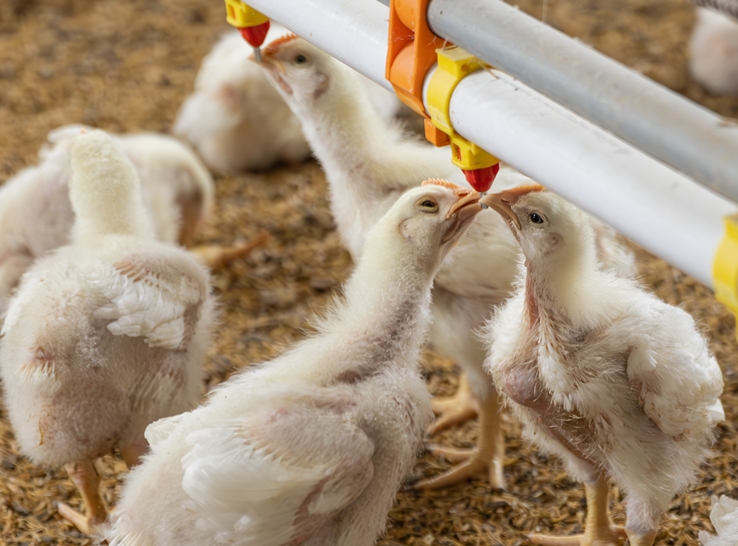Avian metapneumovirus (aMPV) has not been detected in the US since the 1990s. So, it was a surprise in 2023 when a suspect respiratory disease began surfacing in Virginia, West Virginia and North Carolina in broiler breeders and turkeys. These cases were eventually confirmed as aMPV.
By January 31, 2024, the Georgia Poultry Laboratory Network (GPLN) received its first suspect case. “We started receiving reports of unusual signs in meat-type broiler breeders,” said Kathleen Sary, DVM, MSc, GPLN veterinary director.
The birds exhibited aMPV-associated clinical signs, including stargazing, a neurological sign in which the bird’s head and neck are completely extended onto its back. They also had swollen heads and dropped heads, along with respiratory difficulties, higher mortality rates lasting 2 to 3 weeks and a 3% to 5% decline in egg production.
“The neurological signs and mortality rates made us very nervous,” Sary reported at the 2025 American Association of Avian Pathologists Annual Meeting. Testing excluded highly pathogenic avian influenza and Newcastle disease. The diagnosis was determined to be aMPV.
“We found that the neurological signs were due to infection of the ear canal and osteomyelitis of the cranial bone,” she added.
Given the knowledge gaps for aMPV, the GPLN team wanted to investigate the disease evolution in Georgia flocks for one year.
Developing a case definition
The absence of aMPV in the US makes it an emerging disease, Sary noted, meaning it has a new distribution and a new subtype. “We needed to work up a case definition to identify the disease consistently,” she added. This involved specifying clinical signs and using serological or molecular testing (PCR).
The case definition states that an aMPV-naïve flock must have clinical signs that are compatible for the species and have a positive serological test or a molecular test confirmation.
To use serology, there are two commercial kits available, and they require a permit for importing. “Interpretation for these kits can be a challenge,” Sary said.
Molecular testing is reliable, but sampling must be done quickly after the first clinical signs for the best detection. “The advantage is that you can identify the subtype,” she added. “In Georgia, it was subtype B.”
The GPLN team also wanted to look at the aMPV outbreak from different angles. Epidemiologically, they were interested in the virus and disease evolution. “Luckily, our lab had access to saved sera from the National Poultry Improvement Plan (NPIP) monitoring,” Sary said.
They used molecular diagnosis to map the confirmed aMPV cases, which revealed Northeast Georgia had the most cases, with fewer cases in the Northwest and South. “PCR allowed us to confirm cases over different regions,” she said.
“What is curious is that aMPV detection ran from late January to June, then nothing, even into November,” Sary relayed. “But was that due to a loss of interest in testing or a true reduction in virus spread, translating into fewer submissions of suspect cases?”
Setting up the project
With the stored sera in hand and wanting to know more about the disease progression within the state, the GPLN team set up a project to run from November 2023 to November 2024. They generated a list of broiler breeder flocks of 55 weeks and older from the LIMS system.
Distribution of the 289 flocks by region was: Northeast, 158 flocks (55% of the total samples); Northwest, 73 flocks (25%); and South, 58 flocks (20%). “There was a lot more overlap of complexes in Northeast Georgia than in the other areas,” Sary noted.
They divided the project year into four periods: November to December 2023 (before the first case), 34 flocks; January to March 2024 (after the first case), 96 flocks; April to July, 74 flocks; and August to November, 85 flocks.
Once they identified the flocks to be sampled, they thawed and plated 10 sera samples per flock and used a commercial serology kit to test for aMPV. For each flock, the team obtained the geometric mean titers (GMT) and the coefficient of variation.
The virus titer threshold included three categories:
- Negative – below the kit value.
- Equivocal or suspect.
- Positive – using a “limit value” to determine which flocks were positive.
“We used the term ‘equivocal’ because when we compared flocks before the first aMPV break to cases occurring later, we noticed that several flocks were not clinical but were higher than the kit value,” Sary said. “We wanted to ensure those flocks were represented.”
Collecting the results
For the period November to December 2023, 68% of the flocks tested negative for aMPV, with the rest equivocal. For January to March 2024, 18% of the flocks were negative, 14% were positive, and a large proportion in the equivocal category had titers slightly above the kit value. Notably, four out of 14 positive flocks had no clinical signs.
“It begs the question: are flocks getting infected but not showing clinical signs, which means they’re likely subclinical?” Sary noted. “This is a big concern for biosecurity and virus circulation in other flocks.”
The proportion of flocks with positive aMPV titers increased significantly over time from November 2023 to November 2024. “This effect of time can explain the increase of GMT titers in flocks,” she pointed out.
The regional response of the flocks presents more variability when comparing their titers before and after the first reported case in Georgia. While all regions followed the trend toward more positive aMPV flocks after the first case, the Northeast region had significantly more flocks with high GMT results compared to the Northwest and South.
Serology considerations
As Sary noted, interpreting serology results can be a challenge. She conducted a literature review to offer some insights.
- Serology prevalence in the US for aMPV is limited. “It seems there’s more interest in genotyping,” she noted.
- Many labs in the US use serology as a diagnostic tool for aMPV.
- Serology is used as a diagnostic tool around the world.
- Some researchers have given an additional threshold to serology titers to explain their results better.
- Serology paired with performance has uncovered some interesting results. “We have aMPV- positive flocks that don’t show any clinical signs,” Sary added. “That means we must maintain our biosecurity measures all the time.”
Concluding thoughts
Having provided a snapshot in time for this emerging disease in Georgia, Sary presented some final thoughts. “While we are facing an emerging disease, it is interesting to establish the virus exposure to understand its spread in the state better.”
The project identified a shift in seropositivity when the aMPV virus was introduced to naïve flocks.
“Even with serology, we were able to indirectly determine there was virus circulating from the increase in positive titers over time,” she noted.
The long-term question is, will serology still be a reliable diagnostic tool with aMPV vaccination? She concluded, “Using serology as a diagnostic tool may look very different in the future.”







